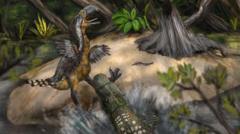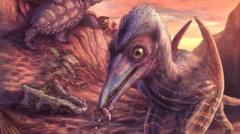Researchers have uncovered a gripping fossil discovery that sheds light on a deadly encounter between two apex predators: a terror bird and a giant caiman. An analysis of teeth marks on a fossilized leg bone from the terror bird, which lived 13 million years ago, suggests it may have met its demise at the jaws of a larger reptilian predator.
The terror bird, a fearsome avian reptile known for its massive stature—up to 2.5 meters tall—had powerful legs and a vicious beak. The research team based in Colombia, led by Andres Link from the Universidad de Los Andes, utilized advanced 3D digital scanning to analyze the impact of bites on the fossilized bone. Their findings matched the marks to those of an extinct caiman species, known as Purussaurus neivensis, a colossal predator that could reach lengths of five meters.
The leg bone in question, unearthed over 15 years ago in Tatacoa Desert's fossil-rich beds, served as a striking example of the interplay between species in an ancient ecosystem. The research, published in the journal Biology Letters, reveals that while the bite marks on the bone show no signs of healing, indicating the bird likely perished in the attack, the researchers have yet to definitively determine if the caiman scavenged the bird's remains afterward.
A deep dive into the sedimentary history of the region reveals that during the Middle Miocene epoch, the Tatacoa area was characterized as a humid swamp teeming with life. This environment facilitated the preservation of remains, alongside the remarkable pursuit of local fossil collector César Augusto Perdomo, who first discovered the leg bone. Together with Perdomo, scientists have cataloged numerous fossils revealing significant insights into this ancient ecosystem’s predatory interactions.
Link emphasized the importance of these findings, not only to understand the dynamics between terror birds and caimans but also to enrich the broader narrative of life on Earth in the past. "Every piece of a body helps us to understand so much about life on the planet in the past," Link remarked, highlighting the ongoing significance of paleontological discoveries in revealing Earth's history. The evidence of this ancient predator clash provides a rare glimpse into the vulnerabilities of terror birds and enriches our understanding of prehistoric life in Colombia’s landscape.

















